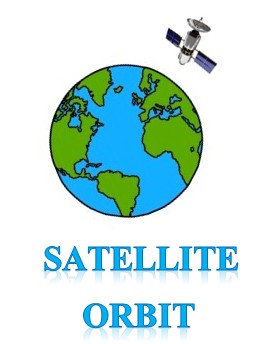Satellite Orbit
Satellites revolve in fixed orbits. These orbits can be either circular or either elliptical in shape.

Circular orbits always maintain same distance to the earth's surface. Hence the attractive force FG of earth due to gravity is equal to m x g x (R/r)2 and centrifugal force Fc trying to pull the satellite away from the earth is given by m x R x w2. i.e., FG = FC.
Where m = mass of satellite: It is the radius of the earth = 6370 km/hour is the distance of the satellite to the center of the earth.
g is the acceleration due to gravity = 9.81 m/sec and w2 is the angular velocity = 2 x p x f where f is frequency of rotation.
In order for the satellite to be placed in the same circular orbit fg = fc i.e.,
m x g x (R/r)2 = m x r x w2
As mass m of the satellite appears on the both sides of the equation it need out be taken into consideration. Hence we can find the distance of satellite from the center of the earth 'r'.
r = (g R2/(2 p f)2)1/3
From the given equation, it is clear that the distance of the earth is directly proportional to the rotation frequency.
Inclination Angle (d)
The angle between the equatorial plane and the plane of satellite orbit is called the inclination angle.
Elevation Angle (S)
The angle between the center of the satellite beam and the tangential plane to the earth's surface is called the elevation angle. It should be more than 100.
Perigee
If the satellite is not revolving in circular orbit then, the closest point so the earth is called perigee.
Foot Print
The area on earth where the signals of the satellite can be received is called foot print.
During satellite communication, there will be some propagation loss of signals. This weakening of signal or attenuation of signal depends on the receiver of earth and satellite. The loss 'L' depending on the distance 'r' between sender and receiver can be calculated as L = (4 x p x r x f)2 where 'f' is the carrier frequency.
Average Acceleration Calculator
Average acceleration is the object's change in speed for a specific given time period. ...
When an object falls into the ground due to planet's own gravitational force is known a...
In Mathematics, the permutation can be explained as the arrangement of objects in a particular order. It is an ordered...
A rectangle can be explained as a 4-sided quadrilateral which contains equal opposite sides. In a rectangle
A three sided polygon which has three vertices and three angles is called a triangle. Equilateral triangle...







